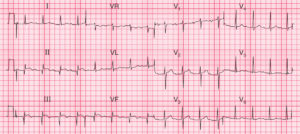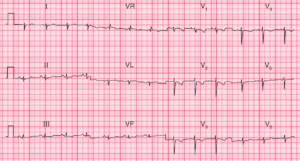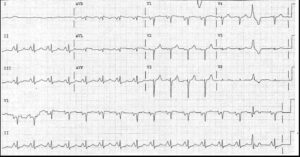This article is an answer to the ECG Case 181
These are three continuous dual-channel rhythm strips. The first strip shows an initial rhythm that is regular at a rate of 110 bpm with a P wave (+) before each narrow QRS complex. There are two ventricular couplets noted (*), and after the second ventricular couplet, there is another sinus complex (▲).
This is followed by a rhythm that does not have any organized ventricular complexes; in contrast, there are rapid and irregular undulations of the baseline. This is ventricular fibrillation.
Ventricular fibrillation is seen on the second rhythm strip and after about 13 sec there is a discharge (↑) from the ICD. Following this, there are eight wide complex QRS complexes (↓) at a slow rate, after which there is the resumption of normal sinus rhythm.
Ventricular fibrillation is one of two arrhythmias that is induced by active ischemia, the other being polymorphic ventricular tachycardia. The occurrence of ventricular fibrillation during an episode of chest discomfort in this patient strongly suggests that there is active ischemia that should be aggressively treated.
MORE CASES:




